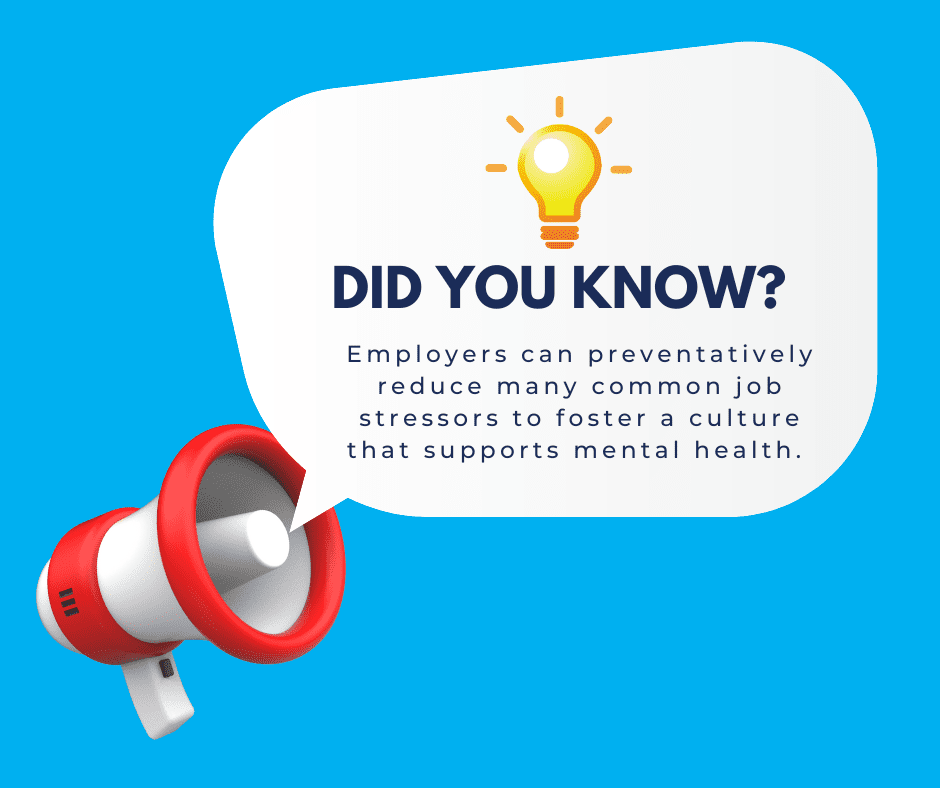Workplace Mental Health Programs
Between personal challenges like caregiving, illness, or loss — and the daily pressures of looming deadlines and endless emails — employees need more from their wellness programs than basic health screenings or smoking cessation initiatives. They need practical solutions to burnout, stress, and absenteeism that directly impact workplace productivity.
Workplace mental health programs provide employees with the tools and support to manage stress, build resilience, and thrive both professionally and personally. For HR and wellness leaders, prioritizing mental health is more than just the right thing to do. It’s also a proven strategy for reducing turnover, boosting engagement, and strengthening organizational performance.
In this article, we’ll explore why workplace mental health programs matter, the impact of stressors at work, and actionable ways organizations can better support their people.
How to Improve Mental Health in the Workplace
In this post:
1. Why Workplace Mental Health Programs Are Essential
2. How Workplace Stress Impacts Employee Mental Health
3. 5 Strategies to Strengthen Mental Health in the Workplace
a. Leadership & Manager Support
b. Employee Education & Mental Health Awareness
c. Providing Access to Mental Health Benefits
d. Building a Culture That Prioritizes Mental Wellness
e. Leveraging Tools and Technology for Mental Health
Why Workplace Mental Health Programs Are Essential
With mental health and stress-related disorders rising, more organizations recognize employee well-being not as a personal issue alone, but as a business priority. Proactively supporting mental health can lower healthcare costs, reduce absenteeism, and strengthen resilience across the workforce. Employees who are properly supported are more engaged, more productive, and better equipped to perform at their highest potential.
It’s a reality: not every day is a good day. When employers understand the challenges their people face, they can take meaningful steps to manage and reduce it. Every workplace is different, yet many employees share common stressors, such as:
- Constant high-intensity workload
- Limited managerial or peer support
- Implied expectations of overtime
- Pressure to avoid taking PTO
- Lack of clear communication
- Job insecurity
- Insufficient staffing resources
- Poor organizational or financial management
Identifying these triggers is the first step toward designing workplace mental health programs that address specific employee needs.
How Workplace Stress Impacts Employee Mental Health
When mental health challenges and workplace stressors go unaddressed, the consequences ripple through both employees and the organization. People might be irritable, impatient, or withdrawn, which harms team morale and collaboration. Persistent stress can also lead to feelings of discouragement, anxiety, or resentment, making it harder for employees to focus and excel in their role.
Over time, emotional strain often translates into physical health issues. Chronic stress increases the risk of depression, cardiovascular problems, obesity, diabetes, arthritis, and other mood disorders. For organizations, ignoring mental health isn’t just a wellness issue — it’s a business risk. High stress and burnout contribute to consistent turnover, less productivity, and increased absenteeism as employees struggle to cope with mounting pressures on both mind and body.
5 Strategies to Strengthen Mental Health in the Workplace
The good news? Organizations can tackle stress head-on while equipping employees to bounce back stronger. By implementing programs, creating supportive policies, and providing accessible resources, organizations can create a culture that prioritizes mental wellness and empowers employees to make healthy choices.
Leadership & Manager Support
Managers are pivotal in any mental health initiative (especially frontline leaders). When you’re trained to recognize signs of stress, emotional distress, or substance use, you can be empathetic and understanding in your approach. This helps employees feel safe discussing mental health concerns.
Some ways managers can support employees are:
- Regular one-on-one sessions. This creates a space for honesty, builds trust, and makes it easier for employees to ask for help before challenges escalate.
- Promoting available resources. Be knowledgeable about counseling, EAPs, or wellness programs so you can highlight them.
- Offering flexibility. Support work-life harmony through adaptable schedules, remote/hybrid options, and prioritized deadlines.
- Modeling self-care behaviors. Demonstrate healthy habits, set boundaries, and take breaks/time off for your own well-being.
Employee Education & Mental Health Awareness
Expanding mental health education beyond leadership teams strengthens the impact of workplace mental health programs. Offering accessible seminars, webinars, workshops, or digital resources helps employees understand mental health, recognize early signs of stress in themselves or colleagues, and know when to seek support.
Equipping employees with these tools creates a culture of empathy, encourages peer support, and empowers individuals to make decisions about their own well-being. Awareness and understanding are the foundation of a workplace where mental health is valued and supported at every level.
Providing Access to Mental Health Benefits
Mental health support should be relevant and accessible. Many comprehensive workplace mental health programs include counseling, EAPs, teletherapy options, and regular wellness opportunities.
Communicate benefits regularly and make enrollment convenient and straightforward. When employees know when to ask for help, what options they have, and how to sign up, they can more confidently pursue a timely solution.
Building a Culture That Prioritizes Mental Wellness
Mental wellness is about how work gets done every day. Employees notice when well-being is prioritized in policies, processes, and routines.
Some practical ways to accomplish this are:
- Integrate wellness into meetings and workflows. Start team meetings with quick check-ins, schedule “wellness breaks,” and avoid back-to-back meetings.
- Recognize and reward healthy behaviors. Acknowledge employees who take mental health days, use EAP resources, or practice self-care.
- Make policies supportive, not punitive. Flexible schedules, clear PTO policies, and realistic workloads.
- Encourage peer support networks. Create forums or buddy systems where employees can share coping strategies and offer encouragement.
Embedding wellness into everyday work allows employees to be supported in real time, for more effective and sustainable mental health programs.
Learn more about promoting health in the workplace.
Leveraging Tools and Technology for Mental Health
Workplace mental health programs are the most effective when supported by the right tools. Digital platforms, apps, and self-service resources can help employees track stress, access counseling, and practice resilience techniques anytime, anywhere.
- Wellness apps — Offer guided meditation, stress tracking, or mindfulness exercises to help employees manage daily pressures.
- Teletherapy and EAP platforms — Provide confidential, easy-to-access counseling and mental health support.
- Data-driven insights — Use anonymized surveys and wellness metrics to identify trends, monitor engagement, and adjust programs to meet employee needs.
- Resource hubs — Centralize articles, videos, workshops, and local support information so employees can find help quickly.
These tech-enabled initiatives make support more accessible, measurable, and responsive.
How Employee Wellness Programs Support Mental Health
Wellness programs give employees concrete ways to consistently monitor and improve their mental and physical health. Survey your workforce to understand their everyday stressors and tailor your initiatives to address those challenges.
Through education, fitness, and stress management, employees recognize risks, get practical tools, and access the right resources at the right time. A comprehensive program might include:
- Monthly health talks (“Same Dish, Healthier Swap,” “Daily Rituals for Stress Relief,” “Releasing Tension in the Body”)
- Weekly stress management class (mindfulness meditation, yoga, stretching)
- Weekly fitness class (Pilates, Strength Training, Zumba)
- Monthly healthy cooking demo
- Quarterly chair massage events
- Honorable mention: virtual wellness coaching programs
This mix of offerings educates, provides outlets, and reinforces healthy lifestyle habits. It also includes fun, engaging ways to show employee appreciation — which goes a long way!
Strive Workplace Mental Health Programs
Strive loves collaborating with clients to design custom wellness programs. Ones that make employees feel good, and also drive measurable outcomes. The sooner you implement a thoughtful mental health program, the sooner your teams will reap the benefits. Book a discovery call to walk through your options and get some actionable guidance.




